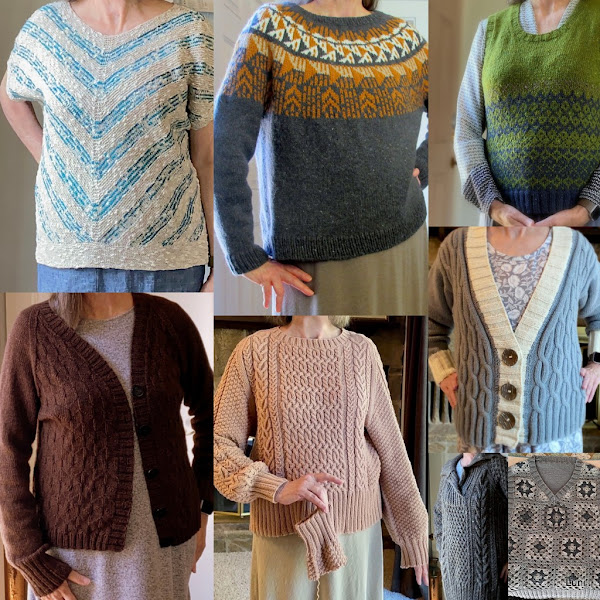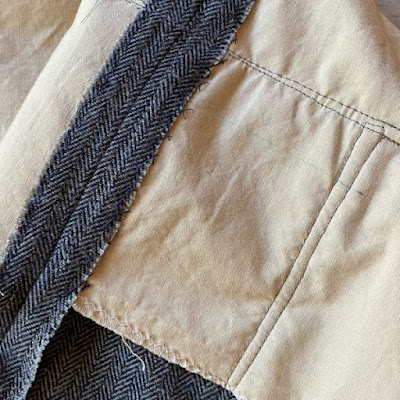Simplicity 8910 again, this time a size 16, larger than my first version of this pattern. Fabric is apparently, again, quilting cotton, this time from Hobby Lobby. The muslin for this dress, the black/white striped fabric from JoAnn, cost $17. This, the green chevron fabric, is prettier and smoother to the touch. There was 3 3/4 yards, only 43" wide, but still plenty. It must be cut with nap because the chevron print is directional. Total cost $18. The skirt was cut 2" longer than the pattern for view C and the v-neck was cut a little narrower--not as high and narrow as the first version but narrow enough to have normal width shoulders.
After the problem I had with the pocket piece not fitting in the first version, that piece is missing now. I had to draft a new piece that fits well.
The 16 worked well, except for the darts. They are simply too long, so were shortened by 1" and brought in a little. However, shorter darts means narrower darts. The larger front waist that results from narrower darts required a few minor changes in the front pleats, keeping all except the two middle ones under 1" and adjusting the side seams in both the bodice and the skirt. The back worked out fine. Sleeves were sewn in with a slightly (1/4") smaller seam allowance in the shoulder, just to make sure the shoulders have enough ease. For full length sleeves, they should be lengthened by 3". With the longer skirt, the hem was 2". Length is good, just below knee.
This one is overall nicer than most of the less costly items but I managed to cut three tiny holes in the skirt when I was trimming the seam allowance with the pinking rotary cutter. There is a small patch behind the holes that hides it. Hopefully, the adhesive strip and fray check will make it last.
Before this dress there was a first draft. The fabric for the first version is a little too stiff, just a 100% cotton from JoAnn, 4001829099403, 2 1/2 yards at $7 per yard. It is a yarn dyed stripe that was cut without nap. With the 20% off, the total cost was $17.
This first version was a Size 14 pattern throughout, with contrast bias binding from the black Elizabeth Suzann cotton poplin I bought from Fancy Tiger. Pattern mods: The v-neck on the bodice is very wide with narrow shoulders, so I widened them to normal width shoulders (2 1/2") and a higher v, lowered the bust darts by narrowing them by 1/4", and sewed the side seams 5/8" at the armhole tapering to 3/8" at the waist. This means the skirt must be widened, a difficult task since the pockets account for a few inches of the skirt width in the front.
The shoulders were too tight and were adjusted by sewing a 3/8" seam at the top of the shoulder only in the bodice portion. The sleeves are very wide at the bottom and narrow over the bicep. A more comfortable fit could easily be achieved by widening the bicep portion.
The pleats as drawn are too large, especially in the front. They do not fit the bodice. It may be possible to use a size or two larger body with the smaller bodice. However, the narrower darts explain some of the mismatch. The pockets do not match the front either. I cut the pocket curve deeper to get it to match the front curve and the binding longer, although it might have been long enough. I made narrower pleats on each side, keeping the two in the middle unchanged.
The pocket binding does pucker a bit, so a longer pocket binding would be nice. There is no need to stretch it along the straight portion, which is most of the pocket edge. Fitting the skirt to the bodice required a little easing, but not much since I spent a good bit of time adjusting the pleats to fit. For some reason, the front is about an inch longer than the back at the hem. However, the length looks even, so it may just be that they did not draw the curve in properly. The next version needs a longer hem, no more than 2" longer, but definitely longer. ETA: the discrepancy in the front v. back hem length was probably due to a sewing problem. I was not aware at the time that I need to watch the feed and avoid letting one length of fabric stretch more that the other.
Lots of problems with this one, but it is a (barely) wearable toile.

Last here is my third version of Simplicity 8910, using "good" fabric and choosing View B, modifying it to the sleeveless version (view A) so that it can be worn as a "jumper" with a shirt. The fabric is an indigo color cross stitch yarn dyed cotton from Stone Mountain and Daughter Fabrics in Berkeley, CA., 4 yards in length, 45" wide (machine wash cold, tumble dry low), made in India, for $56.00. The hand is exceptionally soft for a cotton. The cross stitch pattern is created by two threads that are woven across the fabric lengthwise and crosswise, forming a tiny cross at the intersections on the right side. It is an attractive finish on that side, but on the wrong side, the threads are carried across for nearly 1/2", making it possible to snag them and pull the stitching. On the cut edges, the threads can pull out altogether. Seams and seam finishes may help stabilize the fabric. Definitely, pinking will not be enough. Even though a Hong Kong finish means sewing each seam 5 times (once to stitch the pieces together and twice more on each seam allowance to attach the binding), it was a fairly good solution. French seams would have worked as well but would have been bulkier.

The photo above shows the bound seam allowances and the wrong side of the fabric. The bit of dark blue binding with green spots is the binding in the bodice, the lighter blue is the binding in the skirt.
Since I have sewn this pattern twice before, I made permanent changes to it. View B is a longer option. The longest option, view A, is so long that it would sweep the floor on me. I cut that length away from the pattern since I would never use it. I also cut away the modifications I made to the neckline to make the shoulders normal width and raise the neckline. Since I may wear a shirt under it, I decided to try the more flattering wider neckline. I lowered the dart point by 1" but kept the width in an attempt to make the pattern pieces match. Additionally, I cut the front skirt 1/4" away from the fold so that there will be extra fabric for the pleats. (Clearly, after fitting the bodice and skirt together, my pleating precision is just not enough for this pattern, or as I noted earlier about the pockets, the front pattern piece does not fit the bodice.)
Reviewers of this pattern have written that the armholes gape. This is not a noticeable problem if there are sleeves, but if not, less gaping is better. Cutting the sleeve opening larger under the arm and in front and taking in the side seam by 1/4" improved the fit. Armhole bindings (which had to be a bit longer after my mods) and hong kong finishes on the side seams completed the bodice. The gaping was reduced but I was not satisfied. The binding should have been tighter. As a quick fix, running a thread through the binding around the armhole, pulling it in slightly, did the trick. Another approach, one that I used on the linen jumper I completed last summer, would be to put a small dart from the armhole to the bust. However, that works for my figure and may not for the average.
The front skirt was pleated and pocketed according to instructions, interrupted to add a Hong Kong finish to the pocket edges before basting them down. After pleating the back skirt, the side seams were sewn and finished. At this point, I ran out of the matching navy fabric I was using for bias tape and had to resort to some thrifted fabric in a light blue.
It took a lot of adjusting to make the waist of the skirt the same size as the waist of the bodice. Taking the bodice in an additional 1/4" at the side seams and letting the skirt out an additional 3/8" (leaving only a 1/4" seam allowance that was difficult to finish) made it possible to sew the waist seam. That, too received a Hong Kong finish. Finally, it was hemmed up 2". The length is perfect, about 6" above my ankle.

Now that all the raveling is controlled, I can like this fabric. It is very soft and washes without excessive wrinkling. However, one cross has already pulled out. I put that on the lower back of the skirt and pulled some light blue threads from a fabric scrap to sew it back in. How this fabric will handle being worn and washed repeatedly remains to be seen. Nonetheless, it will get washed and worn frequently. The drape and weight of this cotton adds a lot to the look of the dress. I like it.
Now that this make is completed, I will take a break from sewing to warp my loom. I need to wait for my fabric order to arrive before I decide on my next project.































